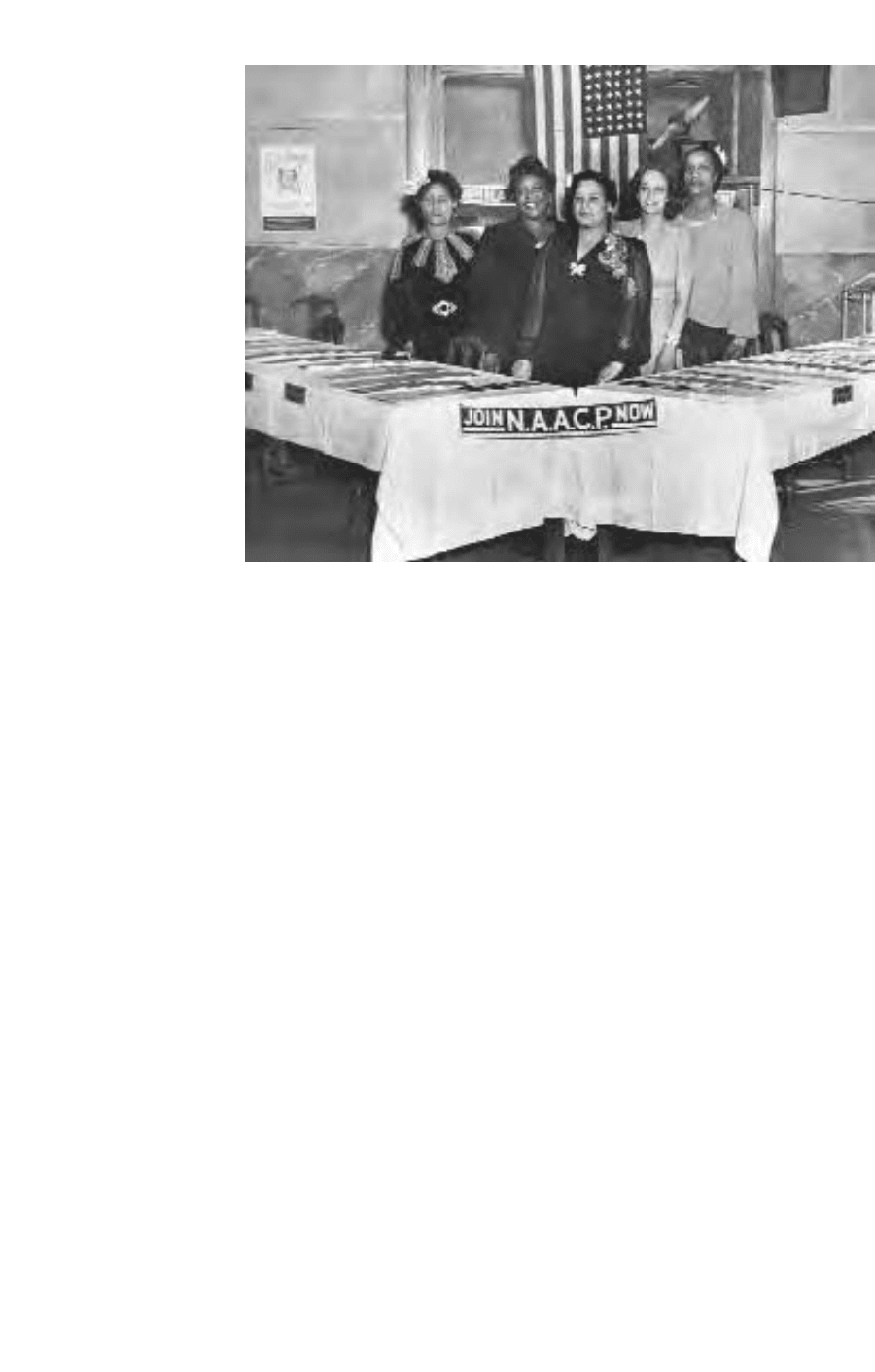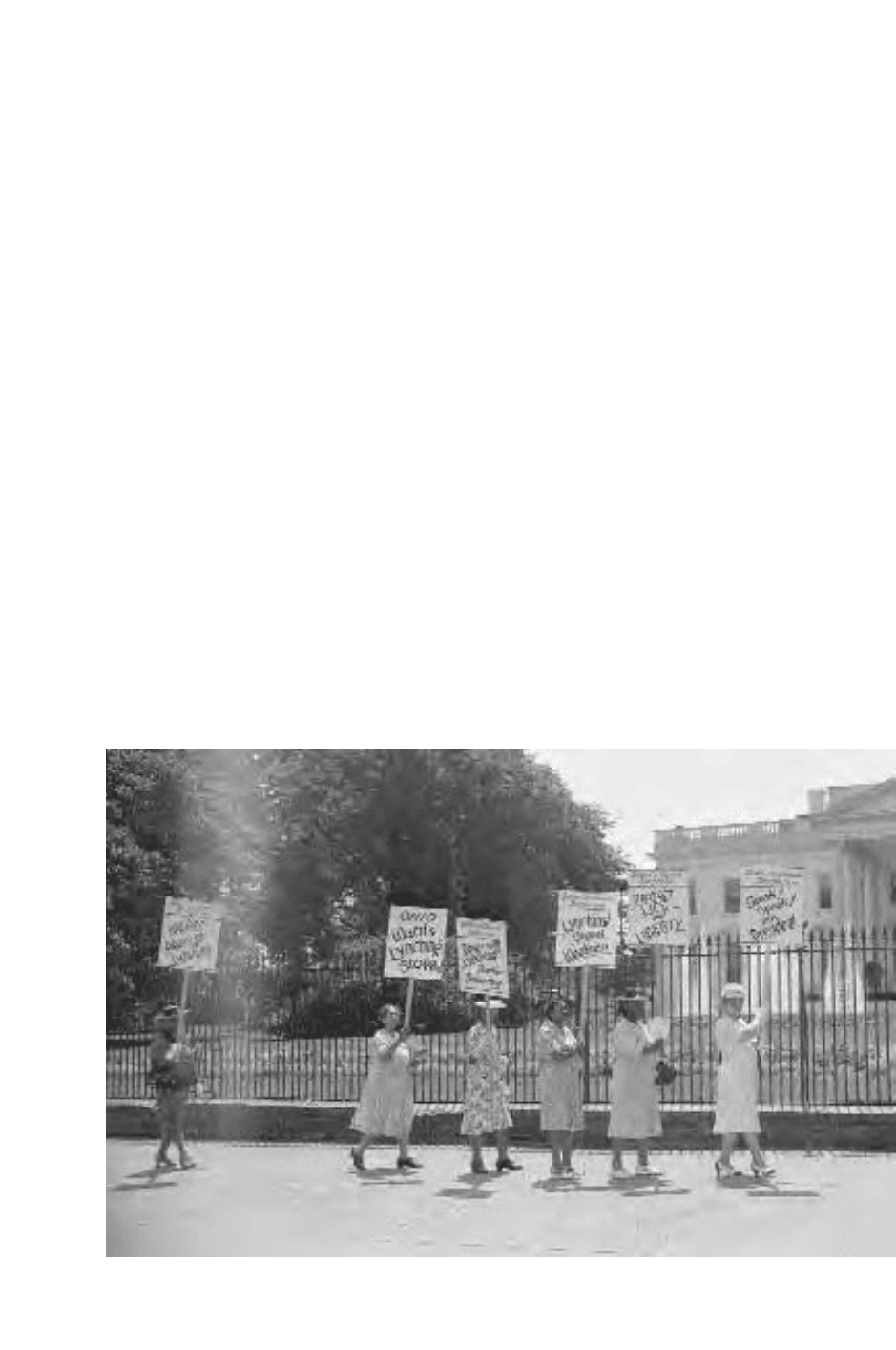Schenken Suzanne O’Dea. From Suffrage to the Senate: An Encyclopedia of American Women in Politics (2 Volumes)
Подождите немного. Документ загружается.


traditionally conducted. Catt presented it to NAWSA’s 1915 convention
and obtained the convention’s approval of it. She also worked to gain Pres-
ident Woodrow Wilson’s support for the amendment, keeping communi-
cations open between them.
When the United States entered World War I, NAWSA financed sev-
eral hospitals in Europe and at home, and NAWSA leaders held visible
roles in federal war agencies. NAWSA members volunteered for the Red
Cross, canvassed their neighborhoods for food conservation programs,
participated in the war service census, and worked on the Liberty Loan
drives. President Woodrow Wilson rewarded these patriotic efforts in
1918 with his announcement that the war could not have been conducted
without women’s contributions and that he supported woman suffrage.
The U.S. House of Representatives passed the amendment in January
1918, but the Senate defeated it in February 1919. The House again passed
the amendment in May 1919, and the Senate followed in June 1919.
NAWSA turned its focus to ratifying the amendment, reaching the goal on
20 August 1920, when Tennessee became the last state needed to add the
Nineteenth Amendment to the U.S. Constitution.
At NAWSA’s 1920 convention, Catt had suggested the creation of an
educational organization to provide newly enfranchised women with in-
formation about citizenship, voting, and related matters. The League of
Women Voters emerged from her proposal.
See also American Woman Suffrage Association; Anthony, Susan Brownell;
Catt, Carrie Clinton Lane Chapman; Congressional Union; League of Women
Voters; National Woman Suffrage Association; Paul, Alice; Shaw, Anna
Howard; Stanton, Elizabeth Cady; Suffrage
References Flexner and Fitzpatrick, Century of Struggle: The Woman’s Rights
Movement in the United States (1996).
National Association for the Advancement
of Colored People, Women in the
Founded in 1909, the National Association for the Advancement of Col-
ored People (NAACP) is the oldest and largest civil rights organization in
the United States, with more than 500,000 members in 2,200 branches lo-
cated in every state, the District of Columbia, Japan, and Germany. The
NAACP has used legal actions as its primary strategy to end discrimina-
tion and to gain full citizenship for African Americans. The organization
also lobbies state legislatures and Congress to ensure and protect the
rights of minority citizens.
A 1908 race riot in Springfield, Illinois, prompted black and white
Americans to join together to fight racism. W. E. B. Du Bois, Ida B. Wells-
Barnett, Henry Moscowitz, Oswald Garrison Villard, William English
National Association for the Advancement of Colored People, Women in the 469

Walling, and Mary White Ovington issued a call to form the organization.
In its early years, several women, including Ida B. Wells-Barnett, Mary
McLeod Bethune, and Mary Church Terrell, made significant contribu-
tions to the development and effectiveness of the organization, especially
in its antilynching campaigns and its attempts, though unsuccessful, to
pass antilynching legislation.
The NAACP worked against racial discrimination in New Deal pro-
grams and in the military during World War II. During the civil rights
movement of the 1950s and 1960s, Daisy Lampkin, Ella Baker, Ruby Hur-
ley, and Daisy Bates were among the notable activists in the organization.
The NAACP provided leadership in developing coalitions for civil rights
legislation, including the Civil Rights Acts of 1957, 1960, and 1964; the
Voting Rights Act of 1965; and the Fair Housing Rights Act of 1968.
In addition to its leadership in Congress, the NAACP has developed
numerous court cases and provided legal support to civil rights activists.
In 1954, the NAACP’s lawyers argued Brown v. Board of Education of
Topeka, Kansas, the landmark case that ended legal racial segregation in
public education. The next year, the organization’s Montgomery Branch
secretary, Rosa Parks, refused to surrender her bus seat to a white man,
prompting the city’s bus boycott. Among the many lawyers working for
the NAACP, Constance Baker Motley assisted in and argued several of the
civil rights cases of the 1950s and 1960s, including defending Martin
Luther King, Jr., and other notable civil rights leaders.
See also Baker, Ella Josephine; Bates, Daisy Lee Gatson; Bethune, Mary Jane
470 National Association for the Advancement of Colored People, Women in the
Women members
of the planning
committee for the
National Association
for the Advancement
of Colored People
standing by tables
loaded with member-
ship information, ca.
1910–1940 (Corbis)

McLeod; Civil Rights Movement, Women in the; Hurley, Ruby; Lampkin, Daisy
Elizabeth Adams; Motley, Constance Baker; Simmons, Althea T. L.; Terrell,
Mary Eliza Church; Wells-Barnett, Ida Bell
References www.naacp.org.
National Association of Colored Women
Founded in 1896, the National Association of Colored Women (NACW)
brought together black women’s clubs across the country into the first na-
tional communications network among African American women. As the
Progressive reform movement emerged in the 1890s, African American
women began to form local service and education clubs in several cities.
When the General Federation of Women’s Clubs refused to accept the
Woman’s Era Club, an organization of African American women, black
women’s clubs became affiliated with either the National Federation of
Afro-American Women (NFAAW) or the National Colored Women’s
League (NCWL). In 1896, the NFAAW and NCWL merged to form the
NACW. The organizing committee elected Mary Church Terrell the
group’s first president.
With the motto “Lifting as We Climb,” NACW members partici-
pated in local projects including kindergartens, day nurseries, orphan-
ages, jail and settlement work, and girls’ homes. Mothers’ clubs, hospitals,
and the needs of black women domestic workers were other areas in
which members worked. The NACW also supported equal rights for
National Association of Colored Women 471
A delegation
representing the
National Association
of Colored Women
picketed the White
House in protest
of the quadruple
lynching at Monroe,
Georgia, 1946
(Corbis/Bettmann)

blacks, work opportunities for black women, and changes in the criminal
justice system. These areas of concern represented the priorities of members
who sought racial uplift as NACW’s primary focus. NACW also worked for
woman suffrage, particularly to include provisions in the woman suffrage
amendment to protect southern black women’s suffrage rights.
After World War I, the number of lynchings increased dramatically,
and NACW responded by mobilizing women to distribute information
about the crime and to raise money for the National Association for the
Advancement of Colored People’s national campaign to end it. In 1922,
Mary Talbert formed the Antilynching Crusaders in an effort to unite 1
million women against lynching and to pass a federal antilynching bill.
NACW published reports on the crime that refuted the myths surround-
ing it, particularly that white men lynched black men in retribution for
black men raping white women. Antilynching legislation did not pass, but
the publicity and other organizational efforts to end the crime con-
tributed to a reduction in the number of instances of it.
By 1920, NACW had 300,000 members and had paid the $5,000
mortgage on abolitionist Frederick Douglass’s home in Anacostia, which
it continues to maintain. When Mary McLeod Bethune became president
in 1924, she led efforts to purchase a building for the organization’s na-
tional headquarters. When she founded the National Council of Negro
Women in 1935 to work for national policy changes, NACW became less
politically involved and more social. By the 1980s, the association’s mem-
bership had dropped to 45,000, where it has remained relatively stable.
See also Bethune, Mary Jane McLeod; Civil Rights Movement, Women in the;
National Council of Negro Women; National Federation of Afro-American
Women; Ruffin, Josephine St. Pierre; Suffrage; Talbert, Mary Morris Burnett;
Terrell, Mary Eliza Church
References Kendrick, “‘They Also Serve’: The National Association of Colored
Women, Inc.” (1990); Slavin, ed., U.S. Women’s Public Interest Groups (1995).
National Association of Commissions for Women
Founded in 1969, the National Association of Commissions for Women
(NACW) is a nonpartisan membership organization of government-cre-
ated regional, state, and local commissions that work to improve the sta-
tus of women. With equality and justice for all women as its mission,
NACW provides leadership on the national level, taking policy positions
on national issues. NACW provides its more than 270 state and local com-
missions for women with technical advice and support.
See also Commissions on the Status of Women; President’s Commission on the
Status of Women
References www.nacw.org.
472 National Association of Commissions for Women

National Coalition Against Domestic Violence
Founded in 1978, the National Coalition Against Domestic Violence
(NCADV) seeks to end violence in the lives of women and children
through a national network of state coalitions and local organizations
serving battered women and their children. The coalition provides tech-
nical assistance to member groups, conducts community awareness cam-
paigns, and develops public policy recommendations. NCADV sponsors
Domestic Violence Awareness Month every October to focus attention on
the problem and a national registry called “Remember My Name” of
women killed as a result of domestic violence.
See also Domestic Violence
References www.ncadv.org.
National Coalition of 100 Black Women
Founded in 1981, the National Coalition of 100 Black Women (NCBW)
develops programs to empower African American women. The organiza-
tion has sixty-two chapters in twenty-three states and the District of Co-
lumbia. The organization’s roots are in a 1970 gathering of African Amer-
ican women in New York City to address the needs of black women,
including the black family, career advancement, and political and eco-
nomic empowerment. Through the coalition’s programs, members devel-
oped leadership skills and sought ways to use them. The membership
grew beyond the 100 in its name, and through the leadership of president
Jewell Jackson McCabe, it expanded into a national organization in 1981.
The coalition’s areas of interest in public policy include affirmative
action, pay equity, equal opportunity, foreign aid, reproductive health
rights, welfare reform, and support for federal appointees. Among the
projects NCBW has sponsored are a program to match pregnant teenagers
with role models, a career exploration program for high school students,
and a model mentoring program. In 1986, NCBW held a colloquy exam-
ining the leadership values of prominent black women, and in 1989 it
launched a health rights education program.
See also Abortion; Affirmative Action; McCabe, Jewell Jackson; Pay Equity
References www.womenconnect.com/ncbw/history.htm.
National Commission on the Observance
of International Women’s Year, 1975
Created by President Gerald Ford’s Executive Order 11832 on 9 January
1975, the National Commission on the Observance of International
Women’s Year, 1975 was later charged by Congress with organizing and
National Commission on the Observance of International Women’s Year, 1975 473

convening a National Women’s Conference (NWC). The congressional ac-
tion, signed by the president on 24 December 1975, was sponsored by
Congresswoman Bella Abzug (D-NY) and constituted U.S. recognition of
the United Nations’ project to focus attention on the problems of women
throughout the world.
Among those appointed to the commission were presiding officer Jill
Ruckelshaus, actor Jean Stapleton, former congresswoman Clare Boothe
Luce, and Republican National Committee chair Mary Louise Smith, all
active feminists. The commissioners appointed committees to review the
progress women had made since the issuance of the 1963 report by the
President’s Commission on the Status of Women and to make recom-
mendations. In addition, an interdepartmental task force was created to
ensure that agencies prepared analyses of the impact of federal programs
on women. The commission made its report in “To Form a More Perfect
Union . . . ,” which included 115 recommendations for policy changes to
improve women’s status. The report became an integral part of the plan-
ning for the 1977 National Women’s Conference.
After the passage of Abzug’s bill, the commission’s tasks changed
from performing research and making recommendations to developing
plans for a national convention, organizing fifty-six state and territorial
preliminary conventions, and providing support to them. In addition,
with the election of President Jimmy Carter, several of the commission
members were replaced with his appointees.
Congress gave the commission a feminist mandate, directing it to in-
volve groups “which work to advance the rights of women,” to “recognize
the contributions of women to the development of our country,” and to
“assess the progress that has been made to date by both the private and
public sectors in promoting equality between men and women in all as-
pects of life in the United States.” The women and men appointed to the
commission generally had strong feminist credentials, and some of them
were feminist leaders, including commission cochair Abzug, Ms. maga-
zine editor Gloria Steinem, Liz Carpenter, National Women’s Political
Caucus chair Audrey Rowe Colom, former congresswoman Martha Grif-
fiths, former first lady Betty Ford, and others. The topical areas that the
commission drafted for the conference’s attention reflected feminist pri-
orities: child care, reproductive rights, employment, the Equal Rights
Amendment, and related issues.
The commission’s duties included appointing state coordinating
committees to organize and convene a state meeting. At the state meetings,
the public participated by choosing delegates to the national conference,
commenting on draft resolutions prepared by the national commission,
and proposing resolutions for the national commission’s consideration.
474 National Commission on the Observance of International Women’s Year, 1975

Although the state meetings were free to select delegates of their choice,
Congress specifically directed the commission to ensure that low-income
women; members of diverse racial, ethnic, and religious groups; and
women of all ages were represented in the delegations. The commission ac-
complished the goal by reserving some delegate assignments to itself and
creating the required balance after the states had selected their delegates.
Congress appropriated $5 million to fund the commission. Some of the
funds were allocated to the states for their meetings, and the balance was
used to provide financial assistance to delegates who could not pay their own
expenses, to prepare and distribute background information and the final
report, to hire staff, and to pay for the conference and its related expenses.
The National Women’s Conference was held in November 1977, and
the commission submitted its report, The Spirit of Houston, to President
Jimmy Carter on 22 March 1978. The commission dissolved on 31 March
1978 as mandated by Congress. Carter established the National Advisory
Committee for Women in April 1978, but its effectiveness was limited by
a disagreement between Abzug, its chair, and Carter. Ultimately, a group
of volunteers formed the National Women’s Conference Committee to
continue the NWC’s work.
See also Abortion; Abzug, Bella Savitzky; Carpenter, Mary Elizabeth (Liz)
Sutherland; Employment Discrimination; Equal Rights Amendment; Ford,
Elizabeth Ann (Betty) Bloomer; Griffiths, Martha Edna Wright; Luce, Clare
Boothe; National Advisory Committee for Women; National Women’s
Conference; National Women’s Conference Committee; Smith, Mary Louise;
Steinem, Gloria Marie
References Bird, What Women Want (1979); East, American Women: 1963 1983
2003 (1983).
National Committee on Pay Equity
The National Committee on Pay Equity is a coalition of more than 180 or-
ganizations working to end sex-based and race-based wage discrimina-
tion. The organization provides leadership, information, and technical as-
sistance to pay equity advocates, public officials, employers, the media,
and the public. The organization supports the proposed Paycheck Fair-
ness Act and the proposed Fair Pay Act.
See also Pay Equity
References http://feminist.com.
National Committee to Defeat the UnEqual Rights Amendment
Organized in 1944, the National Committee to Defeat the UnEqual Rights
Amendment (NCDURA) was a coalition of twenty-seven groups, includ-
ing labor unions, the National Consumers League, the League of Women
National Committee to Defeat the UnEqual Rights Amendment 475

Voters, the National Council of Catholic Women, and the National Coun-
cil of Negro Women. The organization emerged as the Equal Rights
Amendment (ERA) and attracted increasingly favorable attention during
World War II. NCDURA advocated “specific bills for specific ills” instead of
the ERA because the ERA would invalidate protective labor legislation for
women. The organization first proposed an equal pay act as an alternative
to the ERA but was unable to gain congressional approval for the measure.
In 1947, under the leadership of Women’s Bureau director Mary An-
derson, NCDURA changed its name to the National Committee on the
Status of Women and proposed the Status Bill. The bill stated that “no dis-
tinctions on the basis of sex shall be made except such as are reasonably
based on differences in physical structure, biological or social function.”
The measure also included a provision to create a Commission on the Le-
gal Status of Women to study sex discrimination, but Congress did not
pass it. The committee dissolved without passing legislation. President
John F. Kennedy, however, created the President’s Commission on the Sta-
tus of Women in 1961 by executive order.
See also Anderson, Mary; Equal Rights Amendment; League of Women Voters;
National Consumers League; National Council of Negro Women; President’s
Commission on the Status of Women
References Freeman, “From Protection to Equal Opportunity: The Revolution
in Women’s Legal Status” (1990).
National Consumers League
Formed in 1899, the National Consumers League (NCL) sought to im-
prove women’s and children’s working conditions through consumer
pressure and protective labor legislation. At the end of the twentieth cen-
tury, the NCL stated that its mission was “to protect and promote the eco-
nomic and social interests of America’s consumers.” It operates the Na-
tional Fraud Information Center and the Internet Fraud Watch and
manages the Alliance Against Fraud in Telemarketing, the Child Labor
Coalition, and a public service campaign to teach young children what to
do in case of a fire.
The NCL began as a local effort in New York to help retail saleswomen
obtain relief from long hours and low wages. In 1890, a group of philan-
thropists, social reformers, and settlement house leaders established the
Consumers League of New York (CLNY). The group developed a list of
minimum working conditions, including minimum pay at $6 per week, a
ten-hour day, a six-day week, a locker room, a lunch room, and no children
under the age of fourteen. CLNY investigated local retailers, identified
those that met the minimum conditions, and published the results as its
White List. Only eight stores made the first White List, but CLNY leaders
476 National Consumers League

encouraged consumers to limit their purchases to merchants on its list. In
addition, the CLNY encouraged and helped women retail workers organize
unions despite the resistance of male union leaders. As the league expanded
into other cities, it identified sweatshops and the products they made and
encouraged consumers to avoid purchasing items produced by them.
As more cities organized consumers’ leagues, they joined together as
the National Consumers League in 1899. By that time, it had become ap-
parent that voluntary efforts had only limited success, and the organiza-
tion entered a period of professionalization. A key part of the transfor-
mation was the decision to hire Florence Kelley as the first general
secretary. Kelley organized leagues in sixty cities in twenty states and
launched a series of investigations and reports. First, the league investi-
gated workplaces where women’s and children’s stitched cotton under-
wear was produced and documented low wages, long hours, forced speed-
ups, and poor working conditions. The second investigation probed home
work and revealed filthy tenements, people with contagious diseases
working on clothing, starvation wages, and child labor. The third re-
searched child labor, disclosing the 1.7 million children under sixteen
years old working in New England and southern textile mills.
Kelley kept the NCL’s focus on child labor for the rest of her tenure
as the organization’s executive secretary. In 1904, NCL published a hand-
book on child labor that included a state-by-state report on child labor
laws. She helped organize the National Child Labor Committee and, with
Lillian Wald, proposed the creation of a federal commission on children.
President Theodore Roosevelt’s 1909 White House Conference on Child
Health and Welfare provided a forum for the two women to advocate their
proposal. In 1912, Congress created the Children’s Bureau, and NCL pro-
vided the bureau with information that guided the formation of its leg-
islative agenda. NCL advocated passing federal child labor laws and twice
succeeded, but the U.S. Supreme Court found both of them unconstitu-
tional. Proponents next gained congressional approval of a child labor
amendment, but the states did not ratify it. New Deal legislation, however,
prohibited most child labor.
NCL’s 1907 study of self-supporting women’s wages and standards of
living led to the organization’s effort to pass minimum wage laws. Kelley
drafted a model minimum wage law that Massachusetts passed in 1912,
and she traveled the country, speaking on the law and playing a significant
role in nine additional states’ passing similar policies within the year.
NCL also played significant roles in defending protective labor legis-
lation in the courts. The most visible case was Muller v. Oregon (1908), a
challenge to the state’s law limiting women’s workday to ten hours. Kelley
persuaded Louis D. Brandeis, who donated his services, to defend the law
National Consumers League 477

before the U.S. Supreme Court. NCL gathered much of the research for
what became known as the Brandeis brief, an innovation that presented
more than 100 pages of social and economic research to support the de-
fense. NCL raised funds to print the brief and to pay other expenses. The
court decided in favor of Oregon’s law limiting women’s workday. NCL
took thirteen more cases to the courts, and eight of them went to the U.S.
Supreme Court.
In the 1930s, New Deal legislation addressed many of the issues that
NCL had raised, including minimum wage legislation that covered both
women and men, maximum working hours, and child labor. During
World War II, NCL turned its attention to advocacy in state legislatures,
and in the 1950s and 1960s, NCL worked to include migrant workers un-
der state and federal employment laws. Consumer protection and efforts
to reduce child labor were NCL’s focus in the 1990s.
See also Employment Discrimination; Kelley, Florence; Muller v. Oregon;
Protective Legislation
References National Consumers League, Roots of the Consumer Movement: A
Chronicle of Consumer History in the Twentieth Century (1979);
www.nclnet.org.
National Council of Jewish Women
Founded in 1893, the National Council of Jewish Women (NCJW)
emerged from the desire to preserve Judaism by teaching Jewish women
their religious duties. It soon became an advocacy organization address-
ing a wide range of social, health, environmental, and peace issues. Its
more than 90,000 members in more than 500 affiliates seek to ensure in-
dividual and civil rights, improve the status of women, further the quality
of Jewish life, improve day care and public schooling, and promote the
well-being of children and families.
Early projects included founding a religious school for Jewish immi-
grant girls in Chicago and a synagogue in Indiana. Described as a “conduit
through which Progressive ideology entered the Jewish community,”
NCJW provided aid to single immigrant women, meeting them as they
entered the country, offering them housing, and providing other services
to help prevent them from becoming prostitutes. The success of the pro-
grams caused the federal government to seek NCJW’s assistance with im-
migrants. In 1904, NCJW established a permanent immigrant aid station
at Ellis Island to receive Jewish women. Other early programs included
programs for the blind and assistance to delinquent children.
In the early 1900s, NCJW’s advocacy work began with its support for
the 1906 Pure Food and Drug Act and Meat Inspection Act and continued
with advocacy for child labor laws and protective labor legislation for
478 National Council of Jewish Women
